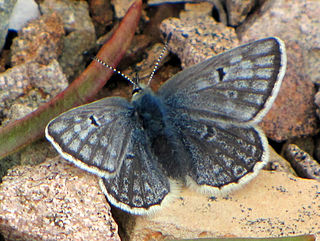
The silver-studded blue is a butterfly in the family Lycaenidae. It has bright blue wings rimmed in black with white edges and silver spots on its hindwings, lending it the name of the silver-studded blue. P. argus can be found across Europe and east across the Palearctic, but is most often studied in the United Kingdom in which the species has experienced a severe decline in population due to habitat loss and fragmentation.

The chalkhill blue is a butterfly in the family Lycaenidae. It is a small butterfly that can be found throughout the Palearctic realm, where it occurs primarily in grasslands rich in chalk. Males have a pale blue colour, while females are dark brown. Both have chequered fringes around their wings.

Cyaniris semiargus, the Mazarine blue, is a Palearctic butterfly in the family Lycaenidae.

Polyommatus eros, the Eros blue or common meadow blue, is a species of blue butterfly found in the Palearctic.

Plebejus is a genus of butterflies in the family Lycaenidae. Its species are found in the Palearctic and Nearctic realms.

Kretania is a Palearctic genus of butterflies in the family Lycaenidae.

The Melissa blue is a butterfly of the family Lycaenidae. It is found in western North America, from Canada to Mexico. The Karner blue is a subspecies of the Melissa blue, and was described by the novelist/lepidopterist Vladimir Nabokov.

Plebejus argyrognomon, common name Reverdin's blue is a butterfly of the family Lycaenidae. The species is named after Jacques-Louis Reverdin.

Plebejus idas, the Idas blue or northern blue, is a butterfly of the family Lycaenidae.

Polyommatus damon, the Damon blue, is a butterfly of the family Lycaenidae.

Polyommatus daphnis, the Meleager's blue, is a butterfly of the family Lycaenidae.

Agriades glandon, the Arctic blue or Glandon blue, is a species of butterfly in the family Lycaenidae. It in found in Eurasia and North America.

Icaricia shasta, the Shasta blue, is a butterfly of the family Lycaenidae. It is found from the northwestern United States to southern Saskatchewan and Alberta.

Kretania pylaon, the zephyr blue, is a butterfly in the family Lycaenidae. It is found in southern Russia and the Middle East to Iran. The habitat consists of dry habitats.

Tomares mauretanicus, the Moroccan hairstreak, is a butterfly of the family Lycaenidae.

Polyommatus golgus, the Sierra Nevada blue, is a species of butterfly in the family Lycaenidae. It is endemic to Spain with habitat in the Sierra Nevada in Andalusia, and is an endangered species.

Kretania eurypilus, the eastern brown argus, is a butterfly found in the East Palearctic that belongs to the family Lycaenidae.

Kretania sephirus, previously known as Plebejus sephirus, is a species of butterfly that belongs to the family Lycaenidae. It is found in Eastern Europe, the Caucasus, and Asia Minor. The species is part of a species complex, with many members of the complex using variations of the name zephyr blue, including pylaon, trappi, and hesperica. The species, which previously belonged to the genus Plebejus, was moved to the genus Kretania following a 2013 molecular phylogenetics study of the subtribe Polyommatina. Many sephirus populations are threatened, and are legally protected in some countries, such as Hungary.


















